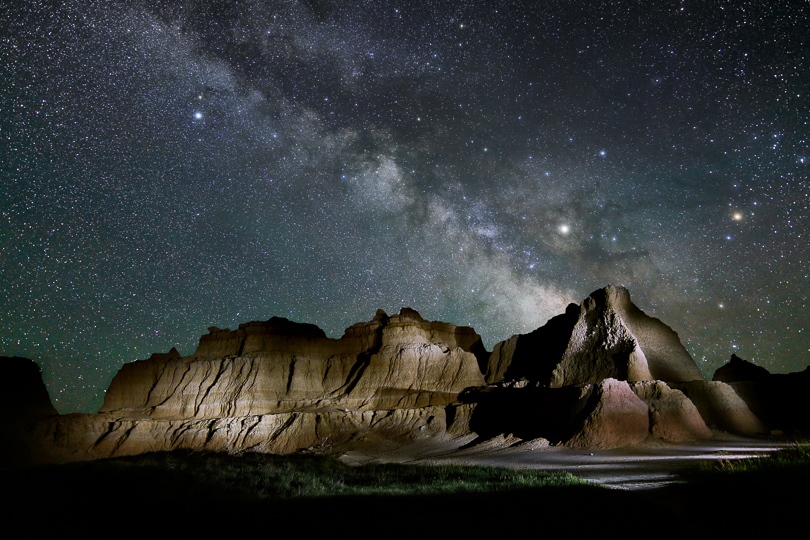 The Milky Way over the Badlands. Nearly all of my night sky photos are done in two pieces. The sky was exposed using a tracking mount to render the stars as sharp dots rather tha n streaks. The foreground was exposed with the tracking mount turned off and I light painted the hills using an LED flashlight. The two pieces are then combined in Photoshop.
The Milky Way over the Badlands. Nearly all of my night sky photos are done in two pieces. The sky was exposed using a tracking mount to render the stars as sharp dots rather tha n streaks. The foreground was exposed with the tracking mount turned off and I light painted the hills using an LED flashlight. The two pieces are then combined in Photoshop. I'm convinced that the fundamental purpose of photography is to allow us to capture a view that couldn't be seen otherwise. There are lots of reasons for taking a picture; we might want to record a scene or an image of a friend to look at later or perhaps to share with someone else. We might want to use photographic technologies to reveal a scene in a way that can't be seen with our eyes. Or we might want to create an image that expresses our own unique way of seeing the world. The first two reasons are pretty obvious. We take lots of snapshots of friends and family just as a way of remembering the event. It's something we can put into a scrapbook to look back at later and I'm sure most of us still carry a few photos of loved ones in our wallets and purses. We treasure photos of people who are no longer with us because it's all we have. I've heard it said that in the event of a fire or other impending catastrophe people will grab the family photo album since it has m any irreplaceable images. Of course today we might also want to grab the computer. I'm a visual person (as I suspect many other photographers are) and while smells and sounds certainly bring back memories, there's nothing like a visual clue to take me back in time. We also love to share our photos. In the "old days, " we would pass around the family photo album while the more "techie" among us might inflict a slide show onto unsuspecting visitors. The internet has made it much easier to share our images and social media platforms form the backbone of our sharing process with Facebook alone receiving 300 million photo uploads per day. Sights posted by friends and acquaintances from around the world are just a scroll and a click away. Besides the usual snapshot, I also post many of my finished fine art images on Facebook as a way of sharing my artwork and I have a dedicated website and blog where I frequently post single images or entire photo galleries.
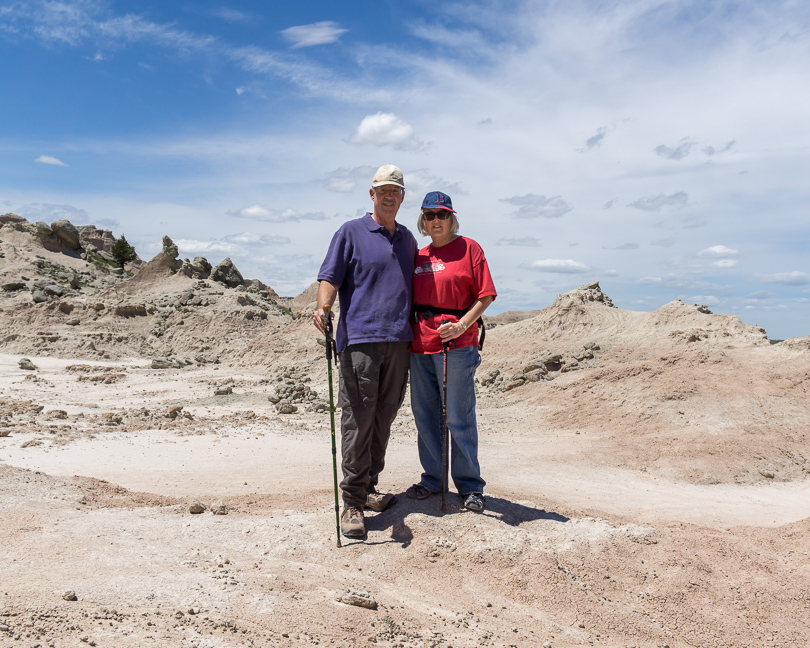 My wife Debbie and I stopped for a quick snapshot along one of the hiking trails in Badlands National Park. We started accumulating an 8X10 print of ourselves from each of our adventures together nearly 20 years ago.
My wife Debbie and I stopped for a quick snapshot along one of the hiking trails in Badlands National Park. We started accumulating an 8X10 print of ourselves from each of our adventures together nearly 20 years ago. Today I like to think of myself as a fine art photographer but my educational background is in mechanical engineering. My technology side loves to play with photographic processes to explore different ways to represent the real world. Of course, no photograph is ever the same as the real thing that was photographed but sometimes the transition from the way we see to the way a camera captures a scene is truly striking. Photography gives us ways to create images we simply cannot see with our eyes. Obvious examples include astrophotography through giant telescopes and photographs of tiny objects through microscopes. Infrared photography allows us to explore the world through wavelengths of light we can't see at all. Moving objects may photograph as a blur or a fast moving object may be frozen in time. Photographic representation of color is another area of exploration. Our eyes and brains work together to create our internal impression of color but it is far from absolute. With exp erience, you can probably detect the difference in color between daylight and incandescent lighting, but a photo of a scene lit by incandescent bulbs will look drastically different if it's processed with a daylight white balance setting versus tungsten. We tend to think of one as being right and the other as being incorrect based on the way we perceive the scene, but what about times when we can't see the color? With a longer exposure or higher ISO cameras can easily record color in a dark scene where our eyes can only perceive black and white. Cameras accumulate the exposure over time and motion is recorded very differently from the way our eyes see. Objects in motion create blurs and moving lights create streaks of light. We can also "paint with light" with a small light source and use the camera's accumulation capability to create a finished image that we were never able to see. Post processing is a big part of digital photographic technology just as the darkroom was a big part of film photography and Photoshop plays a large role when it comes to revealing what we can't see. When the camera captures colors and details we can't see we have a lot of creative freedom to decide how we think it should be represented. Even NASA relies heavily on Photoshop to show us what astronomical wonders would look like if we could see them. Info here.
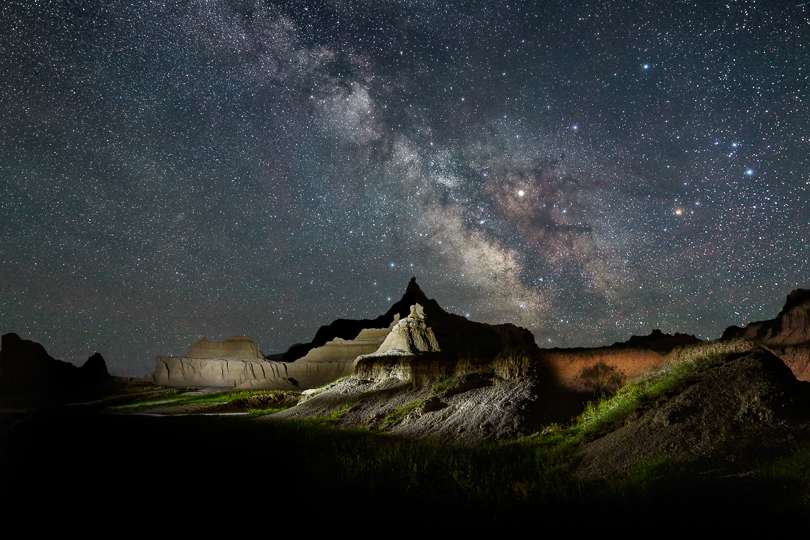 The Milky Way over the Badlands. Again this was done in two exposures, a set of tracked frames for the sky stacked in Photoshop to reduce noise and a light-painted foreground. The red-orange color on the right is from the headlights of a passing car.
The Milky Way over the Badlands. Again this was done in two exposures, a set of tracked frames for the sky stacked in Photoshop to reduce noise and a light-painted foreground. The red-orange color on the right is from the headlights of a passing car. Recently my wife Debbie and I made a trip to Badlands National Park in South Dakota. Besides providing a brief get-away I wanted to spend some time doing night sky and Milky Way photography and the Badlands provided a wonderfully dark sky. Because of the moon phase and position of the Milky Way we generally went out shortly after the moon set in the early morning around 1:00 AM. On our last night in the park, we had two locations in mind so I set the alarm for 12:30 AM. As soon as we got out of town en route to our first location we both noticed a glow in the sky to the north. We commented on it and at first, I wrote it off as a glow from the moon that had recently set just over the horizon so we proceeded with our plan to shoot streaks of light from the car's taillights with the Milky Way over an "S" shaped curve in the road.
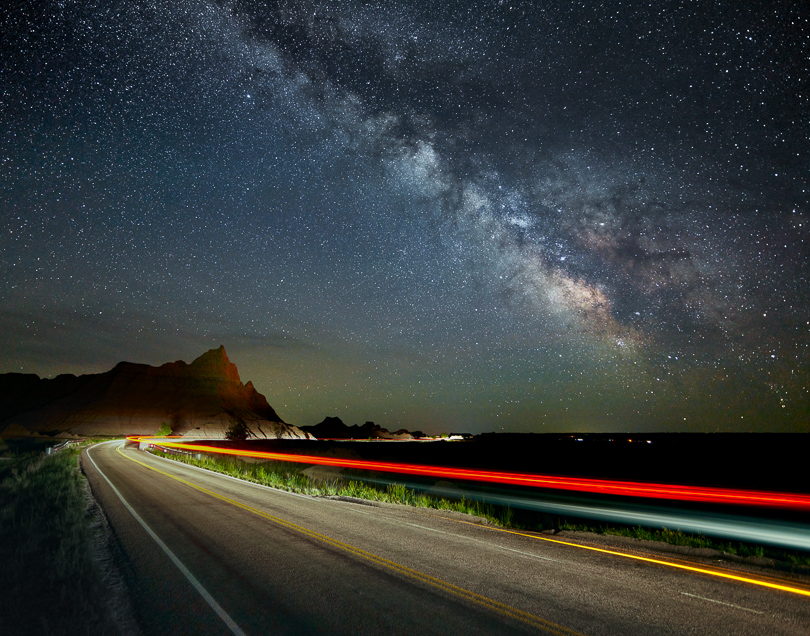 Streaks of light from our car create an interesting foreground that leads to the Milky Way. The sky was exposed separately from the foreground to allow for tracking stars and a different exposure.
Streaks of light from our car create an interesting foreground that leads to the Milky Way. The sky was exposed separately from the foreground to allow for tracking stars and a different exposure. Eventually, it dawned on me that we might be seeing northern lights. By eye, I couldn't see any particular color but I did finally notice the shimmering nature of the light. As a check, I quickly turned the camera around and took a 30-second exposure just to see what it looked like and lo and behold the review image on the LCD clearly revealed the typical green and magenta colors of the aurora.
 The night sky and northern lights the way they looked to my eye. You might be able to see just a little color but our night vision is primarily black and white.
The night sky and northern lights the way they looked to my eye. You might be able to see just a little color but our night vision is primarily black and white. I did a series of more careful exposures of the sky with an unobstructed view of the horizon and then quickly packed up the camera and tripod and moved to a location that offered some interesting foreground structure. Once I was set up I did a set of exposures for the sky and a separate exposure for the foreground again using an LED flashlight to paint with light. During that exposure, a car drove by and added both light and a warm color to my light painting. Unfortunately by then, the aurora was beginning to fade and it was dramatically less interesting than it was just a few minutes earlier. My solution was to use the sky image from 15 minutes earlier in the final image. Because of the combination of light painting and using a tracking mount for the sky images the final version has to be a composite. I simply choose what I felt were the strongest two frames for.
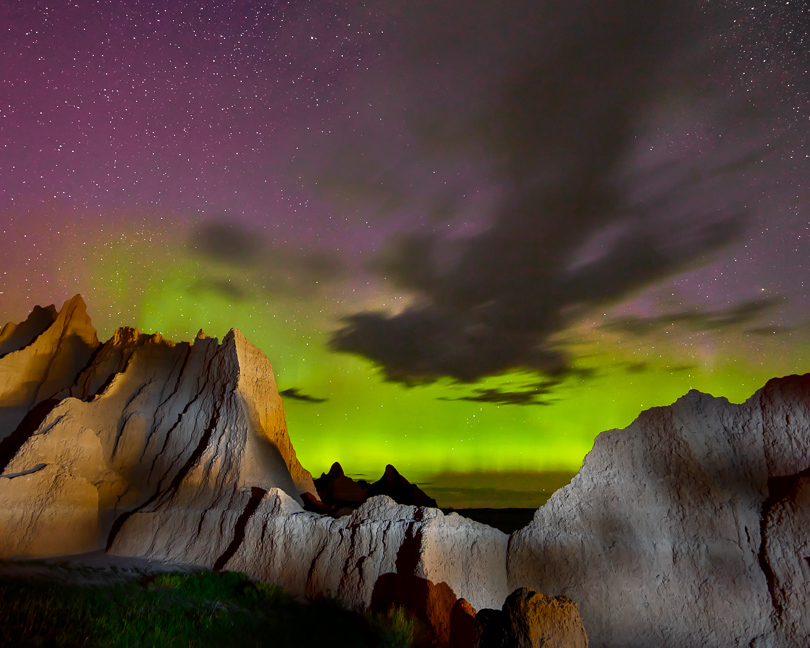 The final composite photo showing light-painted structures in the foreground and a separate exposure for the sky and northern lights. In this case, the sky photo was taken about 15 minutes earlier and about a mile away.
The final composite photo showing light-painted structures in the foreground and a separate exposure for the sky and northern lights. In this case, the sky photo was taken about 15 minutes earlier and about a mile away. That brings me back to the fundamental purpose of photography. I have fond memories of the trip and especially our excitement at seeing the northern lights, so this photo is a memento. I also enjoy sharing my images on my blog, on Facebook and occasionally in an art gallery and this image will soon be expressed as a large print ready to be shared on a wall. This is also a good example of using photographic techniques to bring out the unseen. I couldn't see the colors with my naked eye but there's no doubt that they were there. When I moved the spot of light from the flashlight over the mounds I only saw a moving spot of light, but the camera captured all of the light wherever the beam's spot illuminated the mounds and then combined that with the reddish glow from a passing car's headlights. And like most night sky photos it shows many more stars than I could see. Lastly this photo is an expression of how I like to see and remember the experience. I chose the location and c omposition to show something of the park along with the sky. I added light with a flashlight because I like the way it brings out the textures of the foreground and I like the variation in color created by the passing car. I made the decision to combine these two frames that captured the way I want to remember that night. I adjusted the white balance of the two images so that they looked pleasing and correct to me. The colors in the sky were already rich but I increased saturation just a little so they make bolder a statement. There's no right or wrong answer to the question of how to best express the colors in the sky, especially considering that I couldn't see the colors by eye. You might feel it's best to simply show the scene the way it looks in person, but I find that boring. Besides, we've already seen that. As an artist, I want to show something we haven't seen. In fact, I feel it's my responsibility as an artist to interpret the scene. The camera defaults to a ce rtain set of colors but they're not any more correct than any other rendering of the colors. In the end, it's a personal artistic decision to decide how the colors should be represented. We can all choose the color of our invisible ink and it can be any color you want. There are lots of photos of the northern lights and lots of photos of the Badlands but I like that this image shows my own unique way of experiencing that early morning as we explored the park and enjoyed the night sky.
Craig StocksAugust 2017Source: The Color Of Invisible Ink
No comments:
Post a Comment